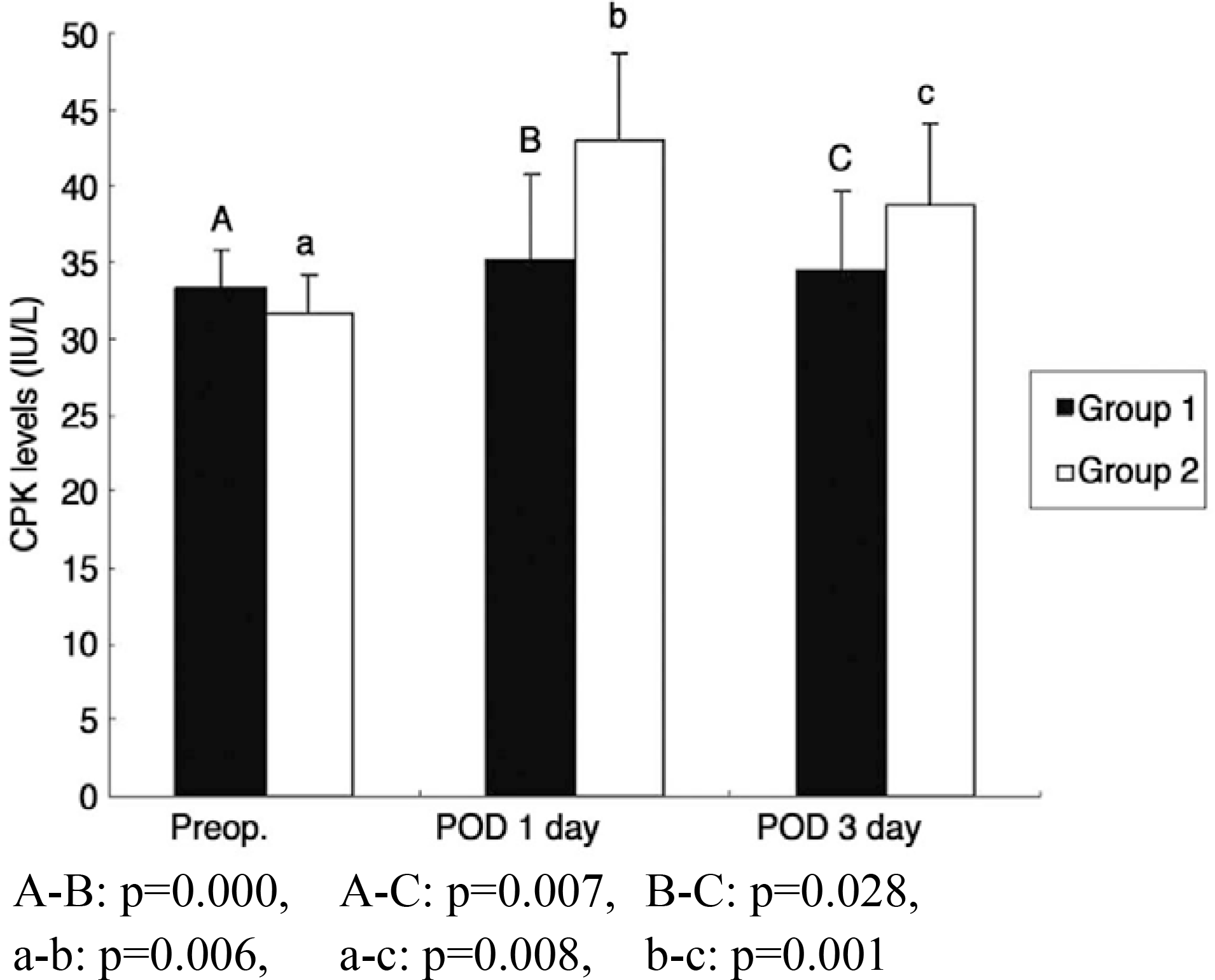Abstract
Objectives
To evaluate postoperative muscle damage after microendoscopic discectomy (MED) and open discectomy (OD), using analysis of serum creatine phosphokinase (CPK) levels.
Summary of Literature Review
Paravertebral muscle damage after retraction during posterior lumbar surgery can cause postoperative back pain. Serum CPK level is elevated in these patients and may indicate postoperative muscle damage.
Materials and Methods
We examined 35 cases with MED (group 1) and 11 cases with OD (group 2). Serum CPK levels were checked preoperatively and postoperatively at day 1 and day 3. We analyzed intra-group and intergroup differences in CPK levels according to sex, age, and operation time. Surgical outcomes were evaluated with a visual analog scale (VAS) preoperatively and 1 year postoperatively.
Results
CPK levels at postoperative 1 day were increased significantly and decreased significantly at postoperative 3 day in both groups (p<0.05), with levels in group 1 significantly lower than in group 2 (p<0.05). There were no differences in CPK levels according to sex, age, or operation time, except between the 3rd and 5th decades of age at postoperative 1 day in group 2. VAS was significantly different in intra-group analysis (p<0.05) with no significant differences in intergroup analysis.
Go to : 
REFERENCES
1). Kawaguchi Y, Matsui H, Tsuji H. Changes in serum creatine phosphokinase MM isoenzyme after lumbar spine surgery. Spine. 1997; 22:1018–1023.

2). Kawaguchi Y, Matsui H, Tsuji H. Back muscle injury after posterior lumbar spinal surgery, A Histological and serological analysis. Spine. 1996; 21:941–944.
3). Kawaguchi Y, Yabuki S, Styf J, et al. Back muscle injury after posterior lumbar spine surgery. Topographic evaluation of intramuscular pressure and blood flow in the porcine back muscle during surgery. Spine. 1996; 21:2683–2688.
4). Kotil K, Tunckale T, Tatar Z, Koldas M, Kural A, Bilge T. Serum creatine phosphokinase activity and histological changes in the multifidus muscle: a prospective randomized controlled comparative study of discectomy with or without retraction. J Neurosurg Spine. 2007; 6:121–125.

5). Sasaoka R, Nakamura H, Konishi S, et al. Objective assessment of reduced invasiveness in MED. Compared with conventional one-level laminotomy. Eur Spine J. 2006; 15:577–582.
6). Huang TJ, Hsu RW, Li YY, Cheng CC. Less systemic cytokine response in patients following microendoscopic versus open lumbar discectomy. J Orthop Res. 2005; 23:406–411.

7). Chiu D, Wang HH, Blumenthal MR. Creatine phosphokinase release as a measure of tourniquet effect on skeletal muscle. Arch Surg. 1976; 111:71–74.

8). Healey JH, Kagen LJ, Velis KP, Levine DB. Creatine kinase MB in skeletal muscle and serum of spinal fusion patient. Clin Orthop. 1985; 195:282–288.
9). Jackson RK. The long term effect of wide laminectomy for lumbar disc excision. A review of 130 patients. J Bone Joint Surg. 1971; 53B:609–616.
10). Mayer TG, Vanharanta H, Gatche RJ. Comparison of CT scan muscle measurements and isokinetic trunk strength in postoperative patient. Spine. 1989; 14:33–36.
11). Weber BR, Grob D, Dvorak J, Muntener M. Posterior surgical approach to the lumbar spine and its effect on the multifidus muscle. Spine. 1997; 22:1765–1772.

12). Kang JS, Lee YK, Cho J, Moon CT, Chang SK. Changes of Muscle Related Enzymes after Posterior Approaches to the Lumbar Spine. J Korean Neurosurg Soc. 2004; 35:23–28.
Go to : 
Figures and Tables%
Table 1.
Summary of datas
| Group 1 | Group 2 | ||
|---|---|---|---|
| Sex | Male | 19 | 8 |
| Female | 16 | 3 | |
| Age (years) | 37.5±9.6 | 37.0±8.6 | |
| 20~29 | 8 | 3 | |
| 30~39 | 13 | 4 | |
| 40~49 | 14 | 4 | |
| Operation level | L3-4 | 1 | 1 |
| L4-5 | 22 | 7 | |
| L5-S1 | 12 | 3 | |
| Operation time (min) | 61.1±16.7 | 67.1±23.1 | |
| < 60 min | 18 | 4 | |
| ≥60 min | 17 | 7 | |
| CPK (IU/L) | Preop. | 33.3±5.5 | 31.6±2.6 |
| POD 1 day | 35.1±4.8* | 43.0±5.7* | |
| POD 3 day | 34.3±5.0** | 38.8±5.3** | |
| VAS | Preop. | 7.4±0.7*** | 7.3±0.7$ |
| POD 1 year | 1.1±0.9*** | 1.0±1.2$ |
Table 2.
The changes of serum level of CPK according to the sex, age, and operation time at operation in group 1
Table 3.
Table 3. The changes of serum level of CPK according to the sex, age, and operation time at operation in group 2




 PDF
PDF ePub
ePub Citation
Citation Print
Print



 XML Download
XML Download